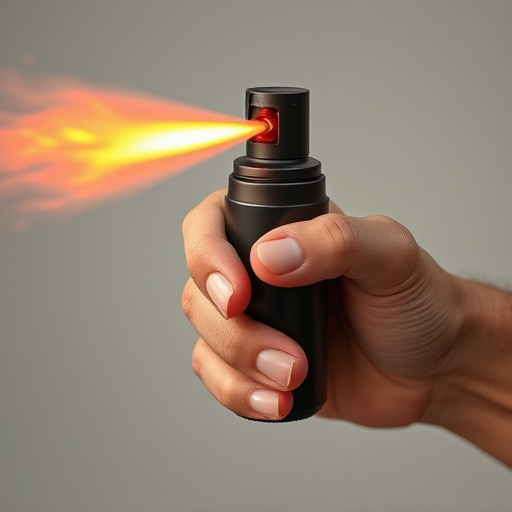Riot control agents like pepper spray are vital law enforcement tools with specific shelf lives. Unopened cans retain potency up to 3 years, while opened containers last up to 2 years. Effective storage, including cool and dry conditions, is crucial for maintaining potency. Law enforcement must follow manufacturer guidelines, promptly use opened containers, and regularly replace supplies to ensure readiness. Strict adherence to these practices preserves equipment viability and enhances operational integrity during deployments.
Riot control agents play a significant role in law enforcement, offering a critical tool for managing chaotic situations. This article delves into the world of these powerful substances, exploring their various types and essential roles in maintaining public safety. We focus on pepper spray as a common riot control agent, examining its shelf life after opening and crucial considerations for officers. Additionally, we discuss legal aspects, regulations, best practices, and safe handling techniques, providing comprehensive insights into effective and responsible riot control agent usage.
- Understanding Riot Control Agents: Types and Their Role in Law Enforcement
- Pepper Spray: A Common Tool, Its Shelf Life, and Considerations After Opening
- Legal Aspects: Regulations and Guidelines for Using Riot Control Agents
- Best Practices for Officers: Safe Handling, Storage, and De-escalation Techniques
Understanding Riot Control Agents: Types and Their Role in Law Enforcement
Riot control agents are chemical substances designed to disrupt and disperse large gatherings of people, often used by law enforcement during civil unrest or high-tension situations. These agents work by causing discomfort, temporarily impairing vision and breathing, and enabling authorities to gain control over a crowd. Common types include pepper spray, tear gas, and smoke bombs. Pepper spray, for instance, is a popular choice due to its relatively mild effects on uninjured individuals while effectively disorienting those affected, allowing law enforcement to restore order.
The shelf life of riot control agents, especially after opening, varies significantly based on the specific chemical composition. Pepper spray, for example, generally maintains its effectiveness for up to 2 years when stored properly and can last up to 3 years past the manufacturing date if unopened. However, once opened, pepper spray starts to degrade, losing potency over time due to exposure to light, heat, and air. Understanding the specific shelf life of these agents is crucial for law enforcement agencies to ensure their equipment remains viable during deployments, with factors like storage conditions playing a significant role in maintaining optimal performance.
Pepper Spray: A Common Tool, Its Shelf Life, and Considerations After Opening
Pepper spray, a common tool in law enforcement and riot control, is known for its effectiveness in neutralizing individuals without causing permanent harm. However, understanding its shelf life and considerations after opening is crucial for optimal use and safety. Typically, pepper spray has a shelf life of around 2-3 years when stored properly, but this can vary based on the manufacturer’s recommendations. After opening, factors like temperature, humidity, and storage conditions significantly impact its potency and longevity.
It’s important to note that once opened, pepper spray begins to degrade faster. Users should be mindful of expiration dates and replace the spray regularly to ensure maximum effectiveness. Proper storage involves keeping it in a cool, dry place away from direct sunlight or heat sources. Even with careful handling, opening the container can lead to a decrease in spray potency over time, so law enforcement officers should consider using up the contents promptly after opening and plan for regular replenishment to maintain readiness.
Legal Aspects: Regulations and Guidelines for Using Riot Control Agents
In many jurisdictions, the use of riot control agents by law enforcement is tightly regulated to ensure safety and accountability. These regulations often include specific guidelines on when, how, and against whom such agents can be deployed. For instance, pepper spray—a common riot control agent—is typically only authorized for use in situations where less lethal force is insufficient, and officers are required to receive training in its correct application to minimize harm.
One crucial aspect that falls under these regulations is the management of pepper spray shelf life after opening. Manufacturers usually provide guidelines on the expected lifespan of the product once the container has been opened. Proper storage conditions, including temperature and humidity levels, play a significant role in maintaining the agent’s effectiveness. Law enforcement agencies must adhere to these guidelines to ensure that their equipment remains viable, thereby upholding the integrity of their operations and the safety of both officers and citizens.
Best Practices for Officers: Safe Handling, Storage, and De-escalation Techniques
When dealing with riot control agents, such as pepper spray, law enforcement officers must adhere to stringent best practices for safe handling and storage. This includes keeping the containers secure, away from direct sunlight, and at controlled temperatures to maintain their effectiveness. Once opened, pepper spray has a limited shelf life of around 6 months, so officers should be diligent in tracking usage and replacing stock promptly.
De-escalation techniques are equally vital. Officers should aim to diffuse situations through calm communication and non-confrontational tactics before resorting to the use of force or riot control agents. Regular training in de-escalation strategies, including recognizing and respecting personal space, using calming language, and understanding cultural nuances, can significantly reduce the need for such agents and promote safer interactions with the public during high-stress incidents.
Riot control agents, such as pepper spray, play a vital role in law enforcement, offering a crucial tool for de-escalating and managing chaotic situations. Understanding these agents’ types, safe handling practices, and legal guidelines is essential for officers to use them effectively while mitigating risks. While pepper spray has a relatively long shelf life, opening the container introduces unique considerations, including reduced effectiveness over time. By adhering to best practices and staying informed about regulations, law enforcement can leverage riot control agents responsibly and enhance public safety.
